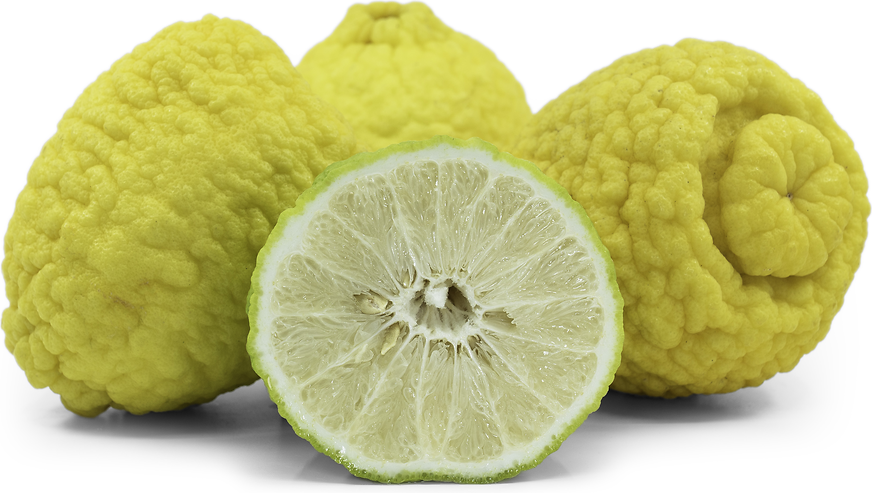


Ponderosa Lemons
Estimated Inventory, ea : 0
Description/Taste
Ponderosa lemons are a medium to large citrus variety, averaging ten centimeters in diameter and two pounds in eight, but the oval to oblong fruits can grow up to five pounds in weight and have a short neck with curved, rounded ends. The rind is smooth, firm, bright yellow-green, and textured, covered in bumps, ribbing, and prominent oil glands releasing fragrant essential oils. Underneath the surface, there is a semi-thick, white, and spongy pith encasing the pale green to yellow flesh. The aqueous flesh is divided into 10 to 13 segments and has a soft consistency, filled with many cream-colored, hard seeds. Ponderosa lemons are highly acidic, developing a bright floral, fruity, and tangy flavor mixed with a subtle sweetness.
Seasons/Availability
Ponderosa lemons are available year-round, with peak seasons in the late spring through summer and again in the winter.
Current Facts
Ponderosa lemons, botanically a part of the Citrus genus, are a very large, hybrid variety growing on evergreen trees reaching seven meters in height, belonging to the Rutaceae family. The textured, bumpy fruits are planted as an ornamental in home gardens and are favored for their ability to be grown in containers near doorways, on patios, or in small gardens. Ponderosa lemons also hold well on the tree, producing fruits year-round, and in some seasons, the flowers will be in bloom simultaneously with the fruits, creating an aesthetically pleasing visual and aroma. Ponderosa lemons are not commercially grown and are cultivated by citrus enthusiasts mainly in the United States as an unusual, novel variety. Beyond its ornamental nature, Ponderosa lemons are edible and can be used as a substitute for table lemon varieties in a wide variety of culinary preparations.
Nutritional Value
Ponderosa lemons are an excellent source of vitamin C, an antioxidant that strengthens the immune system, reduces inflammation, and boosts collagen production within the skin. The fruits also contain potassium to balance fluid levels, fiber to stimulate digestion, and vitamin B6 to assist in transforming food into energy.
Applications
Ponderosa lemons have a similar flavor profile to common table lemons and can be used as a lemon substitute in raw and cooked applications. Many of the large fruits contain adequate juice content that can be pressed and used for salad dressings, sauces, and as a finishing element over grain bowls, ceviche, roasted meats, and stir-fries. The juice can also be stirred into lemonades, cocktails, and sparkling beverages. In addition to the juice, the rind can be zested into vegetables, pasta, and seafood, the whole fruit preserved in salt for extended use, or the fruits can be used as a flavoring for desserts, syrups, and baked goods. Ponderosa lemons pair well with spices such as cinnamon, cloves, ginger, and red pepper flakes, herbs such a bay leaves, oregano, rosemary, and thyme, meats including poultry, turkey, fish, other seafood, blueberries, coconut, bell peppers, dark chocolate, and cheeses such as parmesan, mozzarella, and gruyere. Whole, unwashed Ponderosa lemons will keep 5 to 6 days when stored at room temperature and 1 to 14 days when stored in a plastic bag in the refrigerator.
Ethnic/Cultural Info
Ponderosa lemons were initially known as American Wonder Lemons and were named in honor of their large size. The fruits were later renamed Ponderosa, translating from Spanish to mean “powerful,” and are often described with the nickname “Five-Pound lemon.” One of the most famous Ponderosa lemon trees in the United States is found at Logee’s, a center for home and garden plants in Danielson, Connecticut. Founder William D. Logee established Logee’s in 1892 and purchased the Ponderosa Lemon tree in 1900. The tree was transported from Philadelphia to Connecticut via train and horse and buggy, and ten years after purchase, the tree quickly outgrew its container and was planted in the ground. The Ponderosa lemon tree was one of Logee’s favorite plants in his collection, and as the tree expanded in size, a greenhouse was built around the established tree, known as the “Lemon Tree House.” Logee’s Ponderosa Lemon tree became a national tourist attraction in the 1950s, attracting thousands of visitors, and celebrities, including Katherine Hepburn, Martha Stewart, and Tasha Tudor, paid a visit to the tree. Martha Stewart also featured Ponderosa lemons on her TV Show Martha Bakes, and after the TV segment, she purchased a Ponderosa lemon tree for her garden in Bedford, New York. Stewart recently posted a photo of herself holding a very large Ponderosa lemon on her Instagram in October 2020, showcasing the variety's unique attributes. In the modern-day, the original Ponderosa lemon tree at Logee’s is still alive and growing, now over 120 years old, and the tree is used to produce cuttings for commercial sale.
Geography/History
Ponderosa lemons were discovered as a chance seedling in the garden of George Bowman in Hagerstown, Maryland, in 1887. While the exact parentage of the variety is unknown, experts believe the cultivar's appearance and characteristics may point to a cross between a lemon and citron. In 1900, Ponderosa lemons were released commercially as a home garden variety in the United States and have remained a novel cultivar since their introduction. Today Ponderosa lemons are found through commercial and online retailers for home garden use and are primarily grown in temperate regions of California, Texas, and Florida.
Recipe Ideas
Recipes that include Ponderosa Lemons. One
| Cook Lisa Cook |
|
Ponderosa Lemon & Sour Cream Tart |
| Logee's |
|
Ponderosa Lemon Bread |
| The Kitchn |
|
Heavenly Lemon Bars with Almond Shortbread Crust |

















